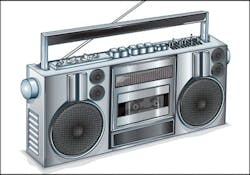Ads that Battle Insurance Company Tactics
When Bob Zak met advertising and marketing specialist Tom Hughes in 1993, Zak was “broke and hungry and going backwards” at his New York collision shop while, in his eyes, insurance company participation was turning into dominance and oppression. Hughes, meanwhile, was hungry for a fight in another market where insurance company “bullies” were making partial payments and insisting on non-original parts.
Hughes loves nothing more than using radio waves to send shock waves in order to teach consumers that insurance companies are taking liberties with their money, their vehicles and, ultimately, their safety.
“We had nothing to lose, at that point,” Zak recalls. “We needed more wrecks in our shop. The DRPs [direct repair programs] and the consolidating and the big chains were sucking in all the business.”
Zak went to the bank and took out a $50,000 loan to pay for a media blitz crafted by Hughes and delivered by Zak — with his voice on the radio and his image on billboards and buses all over town. He never spent a dime of that money because, within the first three months, business increased and, within a year, Elma Collision’s gross profits doubled. A steady diet of Hughes’ advertising flavor, which made some DRP-entrenched shop owners cringe and the others cheer, kept business profitable and growing. In 2001, sales reached $2 million.
Hughes had created a series of messages, supported by jingles and strategic ad placement, that told consumers that sometimes insurance companies don’t pay full labor and parts invoices, that they sometimes insist on aftermarket parts and that they sometimes cause body shops to omit procedures or take shortcuts to make up the difference. Via his clients, Hughes told customers that they don’t need three estimates, that they can choose any collision repairer they like and that sometimes an insurer will steer them to a shop whose work will be molded to fit the insurance company’s budget.
“Customers don’t like to be push-ed around, especially by multi-billion-dollar insurance companies,” Zak says.
Hughes’s aggressive, head-turning marketing strategy helped Elma Collision become one of the best-known autobody shops in the Buffalo, New York area. Before long, Zak was able to remodel and expand the shop, buy new equipment and retain the best staff available. Retired for a few years now, Zak lives in Florida but keeps in touch with and does some commercial voiceover work for his old friend, Tom Hughes.
NEW SET OF RULES
An adage known by some is that we teach people how to treat us. Not only does Tom Rompel, another satisfied Hughes Advertising customer, know the old saying, he enforces it and fairly profits from it at his collision shop in Tucson, Ariz. The message that Rompel puts in the face of any insurance representative who comes knocking is this:
“Don’t cheat my customers out of what they’ve got coming, and don’t tell me how to fix cars because we’re the experts,” he says. Rompel owns Factory Paint & Body collision shop, where aftermarket parts are not part of the repair process. Insurance companies who work with him know this, and even the ones who don’t buy them at other shops pay for every OEM part at his.
He first heard a Tom Hughes message in 1995, while waiting on hold for a shop owner he’d seen speak at a conference. “I immediately recognized this was a new set of rules” in the advertising game, Rompel recalls. Quadrupling his advertising budget, Rompel worked with Hughes to inform Tucson-area customers of their rights. Less than two hours after the radio ad hit the air, Rompel’s phone was ringing. Cars showed up. DRP-shops were scared. “I had this one DRP-hoard tell me that everyone’s upset [about the ads], and when was I going to stop? I looked at him and said, ‘I’m just getting started,’” Rompel recalls.
Insurance companies work hard to keep the consumer misinformed, Rompel says, and when they learn what body shops sacrifice to their insurance “partners,” consumers are often shocked. But a problem he faces with his industry-knocking campaign is that “I’d just built a very big glass house,” with insurance representatives in a wide radius looking closely for a chink in his armor. But Rompel is unconcerned because his shop holds to the highest quality standards for parts and repairs.
“The consumer is very smart,” he says. “They like to think things through on their own, as long as they’re getting all the information they need.”
STAND BY ME
According to Hughes, when an insurance company refuses to pay for an original part or a portion of a repair procedure, it encourages that shop to skimp on the time or the effort or the materials needed to
make the repair.
Insurance companies have the size and strength to “tie people up for years” when there’s a disagreement over a policy or repair reimbursement, he says, adding, “They are putting people at risk; they have no accountability.” Body shops today are facing what Hughes calls “the Wal-Mart-ization of the collision repair industry” and the insurance giants wield intimidation and fear, capitalizing on their power to direct business to shops that play by their rules.
Customers are unaware of the implications of working with shoddy repairers and those who would cut corners in order to make a profit after the insurance companies have squeezed what they can from the mix, says Hughes.
Unfortunately for the many hard-working and honest independent collision shops, as an industry, “You’re only as good as your weakest link,” he quips. “Standards for independent shops are all over the place, and the really good ones keep me believing in humanity. I want body shops to be able to vie for the business and be competitive or fail. The insurance companies need to get out of the way.”
